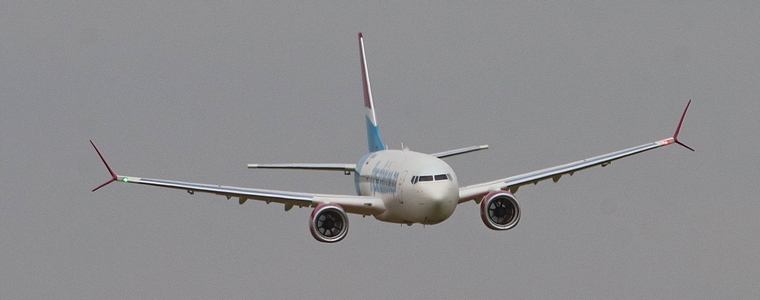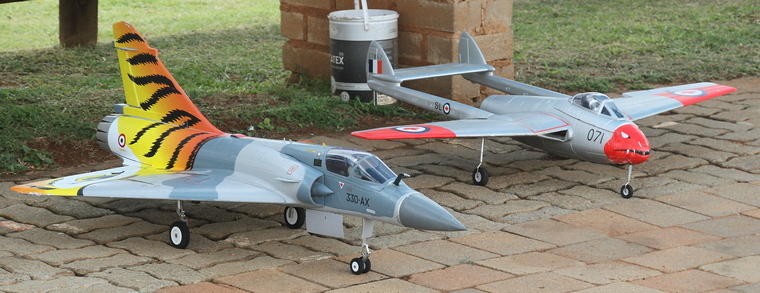Electric Ducted Fans at Pretoria Radio Flyers - March 2020
By Willie Bodenstein


When my friend Daniel Ralefeta, Chairman of "Rise Above Aviators, glider and RC pilot invited me to join them at Pretoria Radio Flyers' (PRF) lovely premises for a day of Electric Ducted Fan (EDF) flying I jumped at the opportunity.



PRF was established in 1964 and after several relocations in the past due to growth and expansion is now situated next to the R50 in Pretoria East just past Rietvlei Nature Reserve.
It rained when I left Johannesburg and did most of the way clearing somewhat when I arrived just after 09.00. The weather for most of the day was to say the least definitely not made for photography. The atmosphere, sense of camaraderie and loads of aircraft already there more than made up for it.
 
A ducted fan is an air moving arrangement whereby a mechanical fan, which is a type of propeller, is mounted within a cylindrical shroud or duct. The duct reduces losses in thrust from the tips of the propeller blades, and varying the cross-section of the duct allows the designer to advantageously affect the velocity and pressure of the airflow according to Bernoulli's principle.

In some cases, a shrouded rotor can be 94% more efficient than an open rotor. The improved performance is mainly because the outward flow is less contracted and thus carries more kinetic energy.
Among model aircraft hobbyists, the ducted fan is popular with builders of high-performance radio-controlled model aircraft. Internal-combustion glow engines combined with ducted-fan units were the first achievable means of modeling a scaled-size jet aircraft. Despite the introduction of model-scale turbojet engines, electric-powered ducted fans remain popular on smaller, lower-cost model aircraft.
EDF engine sizes are classified according the diameter of the duct or shroud in which the fan is placed. Sizes range from 30 mm to 120 mm.

Left to right: Emil Henrico, Daniel Ralefeta and Allen de Klerk with 80mm Freewing L39s
 
Roland Suhmuller 70mm Freewing Yak 130….........Emil Henrico and Mark Coetzee 90mm Freewing F22

Len de Villiers Freewing T-45
 
Dirk vd Bank, Freewing L39 and Christo Barkhuizen, Freewing Avanti S

Left to right: Allen de Klerk, L39, Bruce Bullock, Avanti S and Daniel Ralefeta, L39
 
Emil Enrico, L39............Pierre du Plessis, F4

Brian Currie, Freewing Sabre F86
 
Allen de Klerk, Freewing L39……......Emil Henrico and Mark Coetzee, F22

Left to right: Daniel Ralefeta, L39, Pierre du Plessis, Freewing AL37 and Emil Henrico, L39

Pierre du Plessis with his AL37
More than twenty pilots flying more than fifty plus EDFs attended the fly-in, the first of its kind.


  


Military types, as was to be expected dominated
 
Emil Enrico with his A4.......... Daniel Ralefeta with his 737
Scaled versions of real aircraft varies from tiny to very large.


Two turbine jets joined on Saturday, a large scale Viperjet and a L39
Modern RC aircraft are moulded from styrofoam, colloquially known as foamies. Mass produced, affordable and also surprisingly rugged, foamies today dominate the RC market and EDF's are no exception. An ultra-light material, Styrofoam offers unsurpassed power to weight ratios and some of the aircraft that flew on Saturday were capable of doing 320km/h (200mph).














All Radio-Controlled aircraft activities are controlled by the South Africa Model Aircraft Association (SAMAA). The association consists of various Special Interest Groups (SIG). Although not a special interest group, EDF pilots are a close-knit community, freely sharing advice and assisting each other where necessary.
EDFs are a reasonably affordable way to fly a jet, albeit a radio control version. Kits starts at about R5000.00, excluding radios and batteries. Budget for about R8500.00 and you too can join in the fun.
|
                       |























